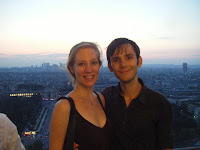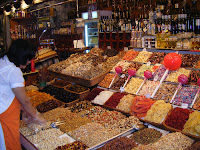As we have obviously failed to update our blog on a regular basis, we have decided to provide a brief summary of the last leg of our trip: Germany.
We arrived in Berlin excited about experiencing another country, but nervous about making the switch from Spanish to German. It proved to not be so difficult, however, because within a few minutes of meeting the family with whom we would be staying for 4 weeks, Ian was talking about his initial impression of the architecture. (It took a few days for Lisa to adjust, but she could understand enough). We had heard that because much of Berlin is undergoing development and there are many unoccupied buildings since the reunification of Germany, apartments are not very expensive. The family with whom we lived had actually purchased two apartments, tore down a wall, and converted them into one. We stayed in Southwest Berlin, about 30 minutes from the center by U-Bahn. The woman was a nurse and now works for an American pharmaceutical company. Her son (our age) was also a nurse and works in the operating room. They were incredibly friendly and inviting. It was great for Lisa to get to talk to them about medical issues and the healthcare system in Germany. She even got to visit a hospital with a young, female neurosurgeon. Unlike in Spain, we had a very large room for ourselves and a private bathroom. We were very comfortable in Berlin; the cool weather added to that.
On the day of our arrival we had to go to the Goethe Institute to take the 3-4 hour entrance exam. Much to our dismay we had to take classes in different parts of the city because of our differing levels. We both tested into the classes we wanted, Ian in C1 and Lisa in A2, C2 being the highest. Although Ian thought he would be prepared for the class (as he had taken a class the previous semester devoted exclusively to German grammar), everything he knew was actually presupposed. This turned out to be advantageous, however, at least after the first week. It was a definite challenge for him in the beginning. Lisa's course covered such topics as discussions about things around the city, holidays, and other common daily conversation topics. In addition to advanced technical aspects of the language, Ian discussed aesthetics, politics and other difficult topics on a regular basis. He had to write a few papers and give one 20 minute presentation over a German author, which was certainly the hardest thing he's had to do in German so far.
One of the most interesting aspects of our classes was that we had classmates from around the world, many of whom did not speak English. We were thus forced to speak German and to learn new words without English translations. This tactic of immersion was very effective. Within 2 weeks Lisa began joining Ian and his classmates in conversation at the Biergarten. We got to meet people from many countries, including Egypt, Brazil, Russia, Israel, South Africa, and Italy. We even got to practice Spanish occasionally. Ian's table partner was from Spain. Because her English was not nearly as good as his Spanish, she would frequently ask him in Spanish what German words were. Lisa was able to hear about how healthcare works in countries with radically different histories and systems of government. Ian spent a lot of time talking about politics and academics with his classmates.
A major advantage of studying at the Goethe Institute was that we were able to take many guided walks around the city with guides arranged by the institute. We took a tour through private art galleries with an art historian and professor from Leipzig. Two of the walks dealt with national socialism and its influence on and destruction of the city. These were lead by a history professor. Before the walks Ian was able to listen to him give lectures on the Weimar republic and Hitler's rise to power. He also heard lectures on "degenerate" art not only during WWII, but also in the former GDR (East German government). We also took a walk led by a participant in the demonstrations against the GDR before the wall fell. The most profound guided tour was led by a former prisoner of a concentration camp in Hamburg. We were led through Sachsenhausen, a former work camp on the outskirts of Berlin. This 5 hour tour was incredibly illuminating, though disturbing. We were impressed by the guide's energy and passion to make known his history, as well as important historical facts that were covered up. He has spent the last few decades giving presentations throughout Europe.
We of course visited many of the traditional tourist and cultural sites: art museums, city landmarks, the wall, etc. (We will put up pictures with some highlights, if you want to see more about that.) In general, the city has an incredibly multicultural feel, with more foreign restaurants than traditional ones.
Although we could go on and on, we will conclude with a few remarks about our trip as a whole. This was, indeed, the trip of a lifetime. We are so grateful to have had the opportunity to basically live in Europe for the summer- trying to speak the languages, changing our daily schedule and diet to fit the common lifestyles, learning about the histories, internalizing the customs, and seeing the sites. We have learned so much, not just academically, but culturally and practically as well.
By the way, we hope to keep updating the blog in order to keep everyone informed about our activities and journey onto medical and graduate school.













